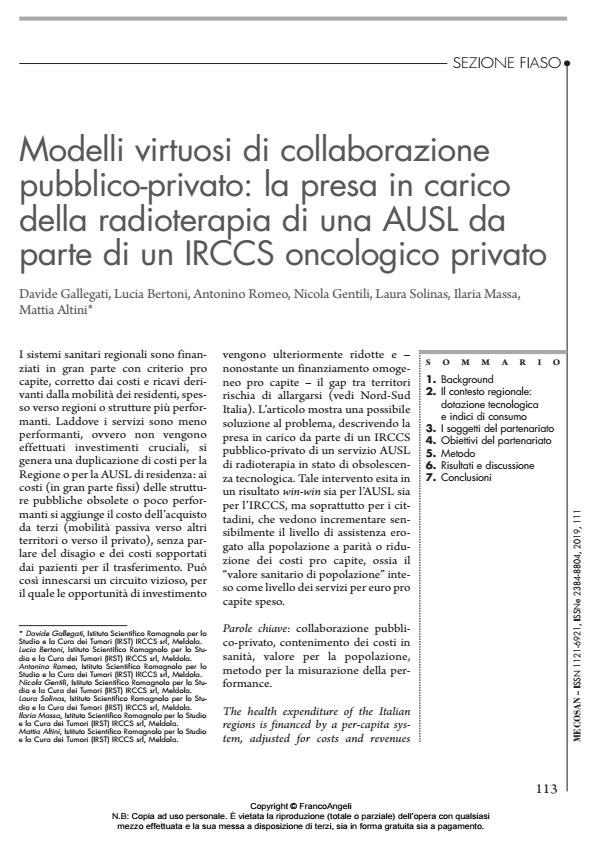Modelli virtuosi di collaborazione pubblico-privato: la presa in carico della radioterapia di una AUSL da parte di un IRCCS oncologico privato
Journal title MECOSAN
Author/s Davide Gallegati, Lucia Bertoni, Antonino Romeo, Nicola Gentili, Laura Solinas, Ilaria Massa, Mattia Altini
Publishing Year 2020 Issue 2019/111
Language Italian Pages 11 P. 113-123 File size 394 KB
DOI 10.3280/MESA2019-111006
DOI is like a bar code for intellectual property: to have more infomation
click here
Below, you can see the article first page
If you want to buy this article in PDF format, you can do it, following the instructions to buy download credits

FrancoAngeli is member of Publishers International Linking Association, Inc (PILA), a not-for-profit association which run the CrossRef service enabling links to and from online scholarly content.
The health expenditure of the Italian regions is financed by a per-capita system, adjusted for costs and revenues induced by the mobility of patients towards more performing Regions or private institutions. In less efficient districts, this translates into cost duplications: in fact, the costs of public structures - which are mostly fixed costs - add up to the costs of purchasing services from third parties (i.e. passive mobility of patients to other regions or to private accredited structures). Moreover, patient mobility generates additional costs for patients, such as travel and accomodation. As a result, the investment opportunities in these districts are greatly reduced; thus, while benefiting from the same levels of per-capita funding, the performance gap between regions is gradually widening. The article presents a Public-Private Parnership between a Cancer Research and Care Center and a Local Health Unit for the management of a radiotherapy service, describing its features and its performance measurement method. Results show that the PPP improved patient care while ensuring the sustainability of the regional health care system and the IRCCS involved. As result, total costs of the Romagna AUSL for radiotherapy showed a significant reduction, while the level of assistance provided improved by greatly increasing the "value" for citizens. The project represents the attainment of a win-win situation: the lower costs for passive mobility induced by the improvement of the service counterbalanced the investments and, at the same time, reduced the per-capita cost of the regional health system.
Keywords: Public private partnership, cost management in health care systems, population-based value, performance measurement method.
Davide Gallegati, Lucia Bertoni, Antonino Romeo, Nicola Gentili, Laura Solinas, Ilaria Massa, Mattia Altini, Modelli virtuosi di collaborazione pubblico-privato: la presa in carico della radioterapia di una AUSL da parte di un IRCCS oncologico privato in "MECOSAN" 111/2019, pp 113-123, DOI: 10.3280/MESA2019-111006